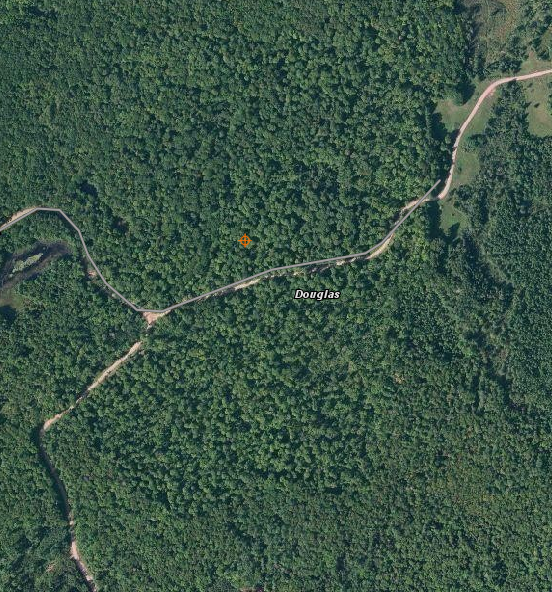Overview
This 92-acre sale is located in west central Douglas County in the Townships of Dairyland and Oakland.
The primary timber management objective is to maintain the northern hardwood timber type through an even-aged silvicultural system of shelterwood with reserves. After the 2000 treatment described here, this is a two-cohort northern hardwood stand.
Silviculture Objective(s)
The silvicultural objective is to maintain northern hardwood timber types through an even aged silvicultural system of shelterwood with reserves. Regeneration should occur through natural seeding and stump sprouts.
Pre-treatment stand description and condition
Pre-treatment species composition:
The primary timber type for this stand pre-treatment was northern hardwood 11-15"dbh. Average stem diameter is 14.85 inches with a current basal area of 113 square feet per acre. Volume averages are around 22 cords per acre for pulpwood and 3,551 board feet per acre for saw logs. Species composition for this stand is as follows: 62% hard maple, 12% soft maple, 8% red oak, 4% yellow birch, 3% white birch, and 11% mixed hardwoods. Past harvesting is evident and may be the result of firewood cutting by early homesteaders.
Landowner objectives/situation:
Several small vernal ponds lie directly adjacent to the sale area as well as an old dilapidated homestead. Soils are predominantly well-drained sandy loams, and lie within the Northwest Lowlands Ecological Landscape. A Landtype Association of Pattison Moraines signifies this Habitat Type of ACL.

Figure 1: Satellite image of Steelbed Homestead sale from Web Soil Survey
Silviculture Prescription
Although sugar maple dominates this site, a habitat type of ACL would indicate that growth and yield for this particular species would be suboptimal, and therefore this stand should probably not be considered for long rotation hardwood management. The silvicultural objective is to maintain northern hardwood timber types through an even aged silvicultural system of shelterwood with reserves. Regeneration should occur through natural seeding and stump sprouts. The residual shelter trees will be retained for aesthetics and to increase landscape diversity. The results should be a two-aged stand or one is of an even aged condition as a consequence of both an extended period of regeneration establishment and the retention of reserve trees that may represent one or more age classes.
A selection tree harvesting method will remove suppressed, overmature, damaged and diseased trees from the stand. Sugar maple, red maple, yellow birch, red oak, white birch, basswood, balsam fir, spruce and pine will be left totaling about 50 ft.² of basal area per acre. The stand had about 113 square feet per acre of basal area prior to the treatment. This sale has been leave tree marked and will be limited to shortwood skidding to minimize damage to the residual stand harvesting operations will be restricted from April 1 through July 31 to prevent bowl damage to residual trees. The Natural Heritage Inventory indicates that there is no threatened or endangered species within the sale area.
Wildlife considerations: A number of large diameter trees per acre that had declining crowns were retained for their den and nesting traits. Red Oak was maintained as a component of the stand and should provide mast. The large amount of edge created by the sale boundary should provide added habitat for those animals that utilize this type of cover.
Water quality considerations: This sale has been designed to avoid water quality problems. Ash drainages, swamped and Vernal ponds have been excavated from the sale area and should not be impacted. Existing logging roads have been used when possible. New logging roads were designed by the Douglas County Forestry Department to minimize excessive road densities, avoid excessive slope and prevent potential water quality problems. After sale completion all logging roads will be restored and bermed.
What actually happened during the treatment
Site was harvested in 2001, successfully producing a two-cohort northern hardwood stand.
Post-treatment assessment
Sept. 2015 Regeneration Status:
Stocking BA 67 square feet/ac
4,333 saplings per acre.
9,000 seedlings per acre.
Sapling and Seedling Regen as of 2015:
- Ironwood 2,167/ac saplings, 1,167/ac seedlings
- Hard Maple 1,500/ac saplings, 7,500/ac seedlings
- Red Oak 167/ac saplings, 167/ac seedlings
- Basswood 333/ac saplings
- Balsam Fir 167/ac saplings, 167/ac seedlings

Figure 2: Steelbed homestead 2-aged NH post-treatment

Figure 3: Steelbed homestead 2-aged NH post-treatment

Figure 4: Sapling regeneration in steelbed homestead 2-aged NH post-treatment

Figure 5: Steelbed homestead 2-aged NH post-treatment
Observations:
- Regeneration is outside browse height and well established.
- Ironwood regeneration is problematic throughout the County.
- Plans for next entry timing and treatment to be determined.
- Continued monitoring will be obligatory.
